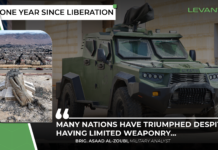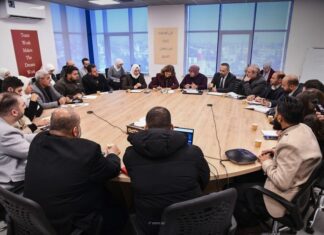
The intricate tapestry of Middle Eastern geopolitics is woven with alliances and rivalries that have shaped the region’s history for decades. In Levant 24’s two-part series, “Complex Companions,” we delve into the convoluted relationships and strategic maneuverings within the Levant. This first article explores the entwined histories of the Palestinian resistance and liberation movements alongside the tumultuous reigns of Syria’s Assad family, from Hafez al-Assad’s calculated rise to power to Bashar al-Assad’s contemporary rule. By examining these intersecting narratives, L24 aims to shed light on the enduring complexities and shifting dynamics that continue to influence the region until today.
A Tangled History
In July 1970, there was significant disagreement within the Baath Party leadership over Jordan’s military actions against Palestinian resistance. Most Baath leaders favored military intervention to support the Palestinians. However, Hafez al-Assad, then the defense minister, opposed direct intervention. This disagreement was a pivotal moment that led to Assad’s Correction Movement, culminating in his seizure of power in Syria on November 16, 1970, marking a new phase in Syrian-Palestinian relations.
Following the Israeli invasion of Lebanon in 1982 and the subsequent control of South Lebanon by Hezbollah, Palestinian resistance forces largely relocated their operations to Damascus. This concentration in Syria was marred by internal conflicts, particularly the expulsion of Fatah from Syria in 1983 after disputes between Assad and Yasser Arafat, the PLO chairman.

Hafez al-Assad’s policy was to control and contain Palestinian factions, a strategy continued by his son, Bashar al-Assad. Palestinians in Syria recall Assad’s refusal to support Palestinian resistance in Jordan (1970-71) and his role in the destruction of the Tel al-Zaatar camp in Beirut. Assad’s manipulation of Palestinian factions, fostering divisions and supporting infighting, aimed to enhance Syrian regional power at the expense of the Palestinian national cause.
Despite rhetoric of support, the Assad regime failed to liberate the Golan Heights or build a modern, united society. Instead, it prohibited armed actions in the Golan, following acceptance of UN Security Council Resolution 242 and the 1974 Golan disengagement agreement, ending military operations from the Golan front and ceasing Palestinian military action against Israel from Syria. This failure undermined the regime’s legitimacy among both Syrians and Palestinians.
Refugees in a Land of Revolution
After his father’s death, Bashar took power, and much like his predecessor, his reign was one of oppression, terror, and exploitation. The Arab Spring gave the people of Syria newfound hope, leading to a national reformation and protest movement yet the Assad regime’s brutal crackdown on Syrian protesters involved mass murder, neighborhood destruction, and the increasing use of heavy artillery, airstrikes, and military reprisals, reminiscent of Hafez’s days in Hama. These actions targeted areas hosting Palestinians since the Nakba of 1948 – a pogrom wherein 80% of the population of Palestine were expelled when Zionists destroyed over 500 villages murdering thousands of the inhabitants in the process – these Palestinians were welcomed by the neighboring Syrians and had shared homes and communities with them since.
The regime pressured Palestinian factions in Syria, such as Hamas, Islamic Jihad, Popular Front for the Liberation of Palestine (PFLP), and Democratic Front for the Liberation of Palestine (DFLP), to support it against the Syrian people. Despite Hamas’s initial attempts to maintain neutrality, the group eventually distanced itself from the regime and maintained its popularity with the Syrian revolution. Conversely, Islamic Jihad maintained its alliance with the regime due to its ties with Iran and Hezbollah.
Some Palestinian militias actively supported the regime, confronting solidarity demonstrations in Palestinian camps and forming security forces to control camp populations for the regime’s benefit. This stance further isolated the splinter groups like Ahmed Jibril’s PFLP General Command (GC) from other Palestinian factions and the broader Palestinian public.
Most Palestinians in Syria reacted positively to the Syrian uprising from its inception, driven by principled and moral stances. Despite the regime repression, Palestinians supported the Syrian people’s demands for freedom and justice, reflecting their shared history and mutual support during times of hardship.
Before 2011, Palestinians in Syria experienced a degree of “Syrianization,” integrating into Syrian society due to relatively lenient restrictions compared to other host countries. This mutual integration fostered a sense of shared identity and solidarity with Syrians against the Assad regime’s authoritarian practices.
A Legacy of Lies & Manipulation
The Assad regime’s relationship with Palestinians was marked by manipulation and co-option, aimed at consolidating domestic power and balancing against US-Israeli interests. Hafez al-Assad viewed Palestinians as a liability, often opposing their initiatives and moderating efforts, thus complicating Palestinian resistance and diplomacy.
The regime’s self-interested policies hindered Palestinian objectives, demonstrating the difficulty of achieving Palestinian goals when obstructed by a key regional power like Syria. The Assad regime’s legacy highlights the complex and often detrimental impact of Syrian policy on Palestinian resistance and the broader Arab-Israeli conflict.

The Syrian regime initially supported Hamas to bolster its regional influence and leverage with the United States. This alliance allowed Syria to present itself as a key player in the “Resistance Axis,” opposing US and Israeli policies in the region.
This relationship served both parties well, with Hamas benefiting from Syrian support and Syria enhancing its standing in the Arab world and among Islamist movements. The alliance was primarily strategic, with both parties using it to further their respective geopolitical goals.
The Resistance & the Revolution
With the onset of the Syrian revolution on March 15, 2011, Hamas attempted to mediate between the Assad regime and the protesters, advocating for genuine reforms and a cessation of violence. Hamas sought to leverage its influence to contain the crisis and avoid further escalation.
As the peaceful protests turned into an armed conflict due to the regime’s brutal crackdown, the Assad regime, along with Iranian envoy Qasem Suleimani, demanded Hamas’s unconditional support against the revolutionary movement. Hamas’s refusal to comply led to a deterioration in their relationship.
Following its refusal to support the Assad regime, Hamas leaders began leaving Syria in December 2011. By November 2012, Syrian authorities had ordered the closure of Hamas offices in Damascus. This marked a significant break from the previous alliance.
In 2012 and 2014 Israel launched a series of attacks in Gaza, operations Pillar of Defense in 2012 and Protective Edge in 2014, both operations consisted of numerous airstrikes against “Hamas infrastructure” and “rocket launch sites” with the 2014 attacks culminating in a ground invasion. These attacks left much of the Gaza strip destroyed and both ended in deals brokered by Egypt, but not before killing over 2,300 Palestinians and 79 Israelis.
During these operations, the Assad regime issued statements condemning Israeli actions but avoided direct references to Hamas. Instead, it focused on factions aligned with the regime, highlighting the ideological shift and strained relationship between the Assad regime and Hamas.
Principles vs Politics
In his 2014 inauguration speech, following what a “consensus of scholars” considered to be “fraudulent elections” held amidst the raging conflict, Assad distinguished between “genuine” Palestinian resistance fighters and those he deemed “fraudulent,” explicitly criticizing Hamas. This rhetoric underscored the regime’s strategy of labeling only its supporters as true resistance fighters, despite Hamas’s active role in combating Israel.
Regime-controlled media continued to support factions like the PFLP-General Command, which were aligned with the regime while downplaying or ignoring Hamas’s contributions. This selective endorsement reflected the regime’s broader strategy of maintaining loyalty-based alliances under the guise of resistance.

The fallout between the Assad regime and Hamas highlights the regime’s flexible approach to alliances, driven by immediate political needs rather than consistent principles of resistance. Once Hamas prioritized humanitarian concerns and declined to support the regime’s oppressive measures, it was quickly marginalized and branded as inauthentic.
This unstable relationship exposes the complexities within the “Resistance Axis” and the Assad regime’s opportunistic policies. The shift in alliances and the rhetoric used against former allies like Hamas reveal the fragile and often contradictory nature of such political coalitions.
Circumventing Contradictions
In the wake of this exploration of the historical interplay between the Palestinian resistance movements and the Assad family’s rule in Syria, it becomes evident that the Middle Eastern political landscape is fraught with contradictions and alliances that defy simple categorization. In the next installment of “Complex Companions,” L24 will delve deeper into the paradoxical relationship between the Palestinian resistance and the Syrian Revolution. Despite the apparent contradictions—wherein Iran, Hezbollah, and the Assad regime claim to align themselves with the Palestinian cause while simultaneously perpetrating atrocities against Syrian revolutionaries akin to those inflicted by the Israeli occupation—the solidarity between these movements endures. Join L24 as the nuanced dynamics that allow these groups to remain sympathetic and supportive of one another amidst the backdrop of conflicting allegiances are examined in the next installment of Complex Companions.








